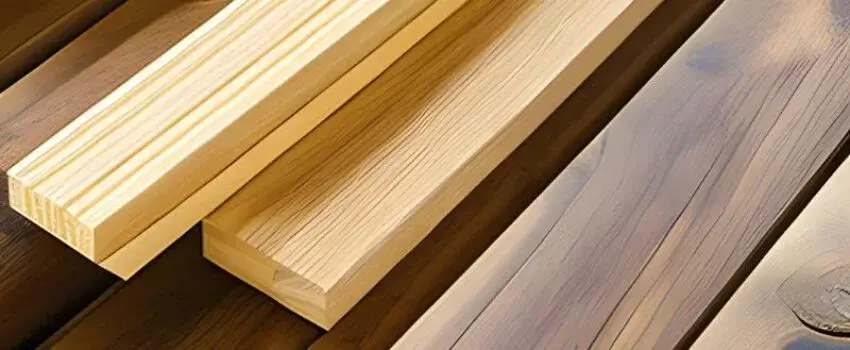Last Updated on August 2, 2023 By Emma W. Thomas
Disadvantages of rubber wood furniture include susceptibility to scratches and dents, limited durability compared to other hardwoods, and sensitivity to water damage. Additionally, some people may be allergic to latex, which is present in rubber wood.
Disadvantages Of Rubberwood Furniture

Rubber wood has some disadvantages that make it not suitable for some pieces of furniture. These include;
Twisting And Warping
Rubberwood has the tendency to twist and warp while it is drying. Warping can cause the lumber to distort before it dries thoroughly. However, if the wood is seasoned, it can become sturdy and durable.
It Is Perishable
Rubberwood has a tendency to decay and it is also perishable. This lumber is also prone to insect and fungal staining which makes it not so suitable for some furniture pieces. This material requires a lot of harsh chemical treatment to prevent these effects. Not everyone is for chemical treatments and this could be a turn-off for many.
May Cause Latex Allergies
For those people that are allergic to latex, rubberwood may be a trigger. Some people experience allergic reactions while using rubberwood and it could be unsuitable for most furniture pieces.
Not Ideal For Outdoor Use
Rubberwood is not very suitable for use in outdoor places as it is moisture absorbent which causes it to deteriorate faster. Rubberwood furniture needs to be kept indoors or in an environment that is less humid.
Texture Difference
One of the main drawbacks of rubberwood is its texture difference. Unlike other woods, this lumber does not have unique wood grains. This lack of unique wood grains means that rubberwood does not dry well and it does not also absorb finishing stains.
Stain Problem
When rubberwood is exposed to chemicals from the seasoning process, it gets a fragile outlook. Cleaning with regular detergents and products stains the rubberwood furniture and it sometimes damages the parawood permanently.
To prevent such damage, it is advisable to clean the wood with warm water and soap only then dry its flooring quickly. You can also use polish oils or grease then wipe immediately to prevent damage to the finish.
What Are The Pros Of Using Rubberwood On Furniture?
Besides the cons the above cons that come with rubberwood furniture, this lumber also has some pros that include;
It Is Sustainable
According to WWF (World Wide Fund for Nature), about 10% of the world’s forests are cut down annually for fast-wood forests. If the rate at which the trees are cut down is higher than at which they are growing, it will have a negative impact on the environment. Such effects include floods, landslides, and erosion and it can also enhance global warming.
Rubberwood harvesting minimizes those effects as the trees could still be burned.
Cost-Effective
Rubberwood is cheaper than other woods since it is considered a byproduct. Most people think of rubberwood as not durable and opt for other timber such as cherry, oak, and maple and this makes it less expensive.
Perfect For Furniture
This type of lumber is processed making it stable with minimal cracking and shrinkage. It is, therefore, ideal for furniture. The wood also has an amazing blonde to medium tan shade.
Absorbs Stains Well
Rubberwood absorbs finishes and stains well. This property makes it great especially if you would like to change the appearance of the wood to suit its setting and your taste.
Easy To Work With
Rubber wood is easy to work with whether by hand or when using power tools. This lumber takes in finishes and stains easily thus producing great results in furniture. It is also perfect for indoor uses and also easy to mold with feed speeds above 20mpm since it accepts paint well.
Nice And Simple Grain
Rubber wood is creamy in color after the sawing process but it turns darker upon drying. It is, therefore, easy to stain it to achieve the appearance of oak, cherry, or walnut. Since rubber wood has heartwood and sapwood that are similar its grain gets a nice coarse appearance. When painting the lumber you will require an acrylic primer followed by an undercoat. You can then finish with two coats of gloss.
Resistant to fire
Rubberwood is a substance that resists burning naturally. Unlike other substances that may burn from such heat sources as cigarettes, its furniture is susceptible to less fire damage. Its fumes are also non-toxic and there is, therefore, no need to worry in case it catches fire.
What is Rubberwood Furniture?
Rubberwood Furniture, as the name suggests, is furniture crafted from the timber of rubber trees, more scientifically known as Hevea brasiliensis. Predominantly grown in the tropical regions of Asia, these trees are the primary source of natural rubber. However, once the trees cease to produce latex, usually after 25-30 years, they are then harvested for the valuable timber they provide, which is subsequently used in the furniture industry.
Characteristics of Rubberwood Furniture
Rubberwood is highly admired for its strength and durability. When treated properly, it resists shrinking, warping, and cracking, making it an ideal material for robust and long-lasting furniture. Its natural light color can be easily stained and finished, which permits a wide range of colors for rubberwood furniture.
Rubberwood contains a naturally occurring anti-fungal property, providing the furniture with considerable resistance against decay. Its uniform grain structure makes it a hassle-free wood to work with and results in an aesthetically pleasing furniture piece.
Sustainability of Rubberwood Furniture
Rubberwood furniture has an added advantage, which makes it not just appealing but also an environmentally conscious choice. Since rubber trees are harvested only after they have stopped producing latex and have thus come to the end of their economic life, furniture made from this wood is considered eco-friendly. Under normal circumstances, such spent trees would be incinerated, thereby directly contributing to air pollution. Using harvested wood for furniture essentially adds a step to the rubber lifecycle that not only prevents waste but also benefits our homes and offices with quality furniture.
Is Rubber Wood Water Resistant?
Like any other hardwood, rubberwood has varying degrees of quality. This material is not ideal for outdoor application since the rain can leach its protective chemicals. The lack of protective chemicals exposes the wood to insect and fungus attacks. When the wood is exposed to excess moisture, it can warp and rot.
Does Rubberwood Scratch Easily?
Rubberwood does not scratch easily since it has almost similar hardness as teak and walnut but is slightly softer than oak. Rubberwood is moderately hard with a medium texture and the same weight and density as ash or maple.
Which Is Best Pine Or Rubberwood?
It may not be easy to compare pine to rubberwood. Rubberwood is a hardwood that is usually imported as less expensive indoor furniture while pinewood is a softwood that is native resinous that makes both exterior and interior furniture. Pinewood is extensively available to cabinet-makers and carpenters.
These two types of wood differ greatly in quality and deicing which is the best may depend on personal preference as well as whether you want wood for making cabinets or for construction or you need ready-made furniture.

Conclusion
Rubberwood has some disadvantages such as warping and twisting, perishability, may not be suitable for outdoor use, and it also triggers latex allergies. It is, however, used for furniture since it is cost-effective, can be durable if seasoned properly, and it also takes in stains well.
This lumber is also sustainable since it’s grown for latex harvesting and can be cut down once its usefulness for this purpose is over. Cutting down rubberwood prevents using other alternative timber which may lead to deforestation which causes other issues such as soil erosion, floods, and landslides.
References:
https://woodworkly.com/is-rubberwood-good-for-furniture/
https://usvintagewood.com/pros-and-cons-of-rubberwood-for-furniture/
Emma is a graduate of Domestic Science or Family and Consumer Sciences (Home Economics) from the University of Wisconsin. She has 7 years of experience Working with the strategic section of BestBuy and now writing full-time for Homeeon.
From Managing the Home, Interiors, Cleaning, and Exteriors to Gardening and everything about Making A Home Liveable – is her passion and this Homeeon is the result of this.
Emma loves decorating her home with the best stuff found online. She cares about quality over anything and writes reviews about them here in Homeeon. Get in touch with her over Pinterest.
Keep reading her blogs.

